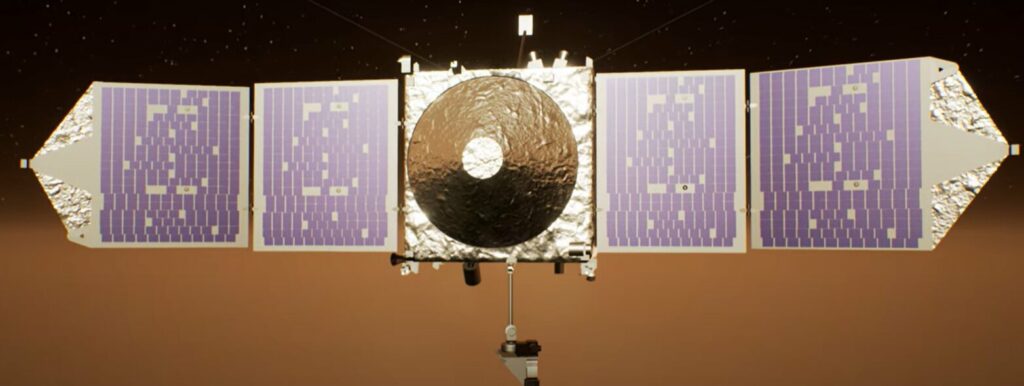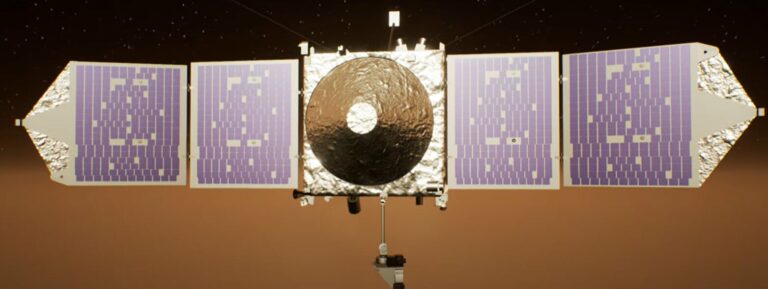NASA’s MAVEN Witnesses the Vanishing Solar Wind
In December 2022, NASA’s MAVEN mission made a remarkable discovery regarding the solar wind. This continuous stream of charged particles emitted by the sun experienced an unexpected and dramatic “disappearance.” The cause of this phenomenon was a powerful solar event that left a void in its path as it traversed through the solar system.As a result of this event, MAVEN’s measurements at Mars revealed a significant decrease in the number of particles comprising the solar wind. Without the pressure exerted by the solar wind, the Martian atmosphere and magnetosphere expanded by thousands of kilometers. MAVEN, being the sole asset present at Mars capable of simultaneously observing the sun’s activity and the response of the Martian atmosphere to solar influences, played a crucial role in capturing this data.
Jasper Halekas, a professor at the University of Iowa and the lead author of a new study on this event, expressed his astonishment at the data. The drastic drop in the solar wind was almost unbelievable, prompting the formation of a working group to investigate further. This period of time has yielded remarkable findings, making it an exceptionally fruitful research endeavor.

Mars, like all other planets in our solar system, is constantly subjected to the solar wind. This solar wind exerts pressure on the Martian magnetosphere and ionosphere, playing a significant role in the escape of the atmosphere. The solar event in December 2022 occurred when faster-moving solar wind overtook slower-moving solar wind, resulting in a sweeping and compressing effect on the two regions.This interaction, known as a stream interaction region, left behind an uncommon void of solar wind with extremely low density. MAVEN was able to observe this “disappearance” of the solar wind, leading to extraordinary interactions within Mars’ magnetosphere and ionosphere.
The decrease in density of the solar wind by a factor of 100 resulted in a significant decrease in pressure. This allowed the magnetosphere and ionosphere of the planet to expand by thousands of kilometers, more than tripling their typical size. This expansion also brought about a dramatic change in their characteristics. The sun’s magnetic field, which is usually embedded within the Martian ionosphere, was pushed outward, causing the ionosphere to transition from a magnetized state to an unmagnetized state.
Simultaneously, the region between the solar wind and the magnetosphere experienced an unusually quiet electromagnetic environment. The observations made by MAVEN during this remarkable event, along with the subsequent transformation and expansion of the entire system, are crucial in enhancing our understanding of the underlying physics that drive atmospheric and water loss on Mars.
“We are truly witnessing how Mars reacts when the solar wind is effectively diminished,” added Halekas. “This serves as an exceptional study to explore what Mars would be like if it were orbiting a star with less intense solar winds.”
Disappearing solar wind events of this magnitude are exceptionally uncommon and occur during a period of heightened solar activity, making it a unique opportunity for the MAVEN mission to observe such a phenomenon. While other spacecraft at Mars and Earth also detected certain aspects of this event, only MAVEN was able to simultaneously measure both the sun and the response of the Martian atmosphere to it.
According to Shannon Curry, the principal investigator for MAVEN at the University of California, Berkeley, the scientific value of observing extreme conditions cannot be overstated. MAVEN was specifically designed to study these types of interactions between the sun and the Martian atmosphere, and it provided exceptional data during this truly anomalous solar event.
As the sun approaches solar maximum, the peak of its 11-year activity cycle, the MAVEN mission has the potential to significantly contribute to our understanding of extreme solar events.
Gina DiBraccio, the MAVEN deputy principal investigator and deputy director of the Heliophysics Science Division at NASA’s Goddard Space Flight Center in Greenbelt, Maryland, emphasized the multifaceted role that MAVEN plays at Mars. Not only does it observe the dynamics of the Martian atmosphere, but it also monitors solar inputs to enhance our comprehension of the sun.
The findings of this study are being presented at the American Geophysical Union Fall Meeting in San Francisco.
This article is republished from PhysORG under a Creative Commons license. Read the original article.
Do not forget to share your opinion with us to provide you with the best posts !




0 Comments